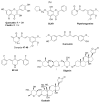New Trends in Aging Drug Discovery
- PMID: 36009552
- PMCID: PMC9405986
- DOI: 10.3390/biomedicines10082006
New Trends in Aging Drug Discovery
Abstract
Aging is considered the main risk factor for many chronic diseases that frequently appear at advanced ages. However, the inevitability of this process is being questioned by recent research that suggests that senescent cells have specific features that differentiate them from younger cells and that removal of these cells ameliorates senescent phenotype and associated diseases. This opens the door to the design of tailored therapeutic interventions aimed at reducing and delaying the impact of senescence in life, that is, extending healthspan and treating aging as another chronic disease. Although these ideas are still far from reaching the bedside, it is conceivable that they will revolutionize the way we understand aging in the next decades. In this review, we analyze the main and well-validated cellular pathways and targets related to senescence as well as their implication in aging-associated diseases. In addition, the most relevant small molecules with senotherapeutic potential, with a special emphasis on their mechanism of action, ongoing clinical trials, and potential limitations, are discussed. Finally, a brief overview of alternative strategies that go beyond the small molecule field, together with our perspectives for the future of the field, is provided.
Keywords: aging; drug discovery; senescence.
Conflict of interest statement
The authors declare no conflict of interest. The funders had no role in the design of the study; in the collection, analyses, or interpretation of data; in the writing of the manuscript, or in the decision to publish the results.
Figures




Similar articles
-
Hsp90 inhibitors as senolytic drugs to extend healthy aging.Cell Cycle. 2018;17(9):1048-1055. doi: 10.1080/15384101.2018.1475828. Epub 2018 Jul 23. Cell Cycle. 2018. PMID: 29886783 Free PMC article. Review.
-
A Senescence-Centric View of Aging: Implications for Longevity and Disease.Trends Cell Biol. 2020 Oct;30(10):777-791. doi: 10.1016/j.tcb.2020.07.002. Epub 2020 Aug 13. Trends Cell Biol. 2020. PMID: 32800659 Review.
-
Targeting normal and cancer senescent cells as a strategy of senotherapy.Ageing Res Rev. 2019 Nov;55:100941. doi: 10.1016/j.arr.2019.100941. Epub 2019 Aug 10. Ageing Res Rev. 2019. PMID: 31408714 Review.
-
Drugs that target aging: how do we discover them?Expert Opin Drug Discov. 2019 Jun;14(6):541-548. doi: 10.1080/17460441.2019.1597049. Epub 2019 Apr 11. Expert Opin Drug Discov. 2019. PMID: 30973028 Free PMC article. Review.
-
New Horizons: Novel Approaches to Enhance Healthspan Through Targeting Cellular Senescence and Related Aging Mechanisms.J Clin Endocrinol Metab. 2021 Mar 8;106(3):e1481-e1487. doi: 10.1210/clinem/dgaa728. J Clin Endocrinol Metab. 2021. PMID: 33155651 Free PMC article. Review.
Cited by
-
Exploring the anti-aging potential of natural products and plant extracts in budding yeast Saccharomyces cerevisiae: A review.F1000Res. 2024 Dec 17;12:1265. doi: 10.12688/f1000research.141669.2. eCollection 2023. F1000Res. 2024. PMID: 39822944 Free PMC article. Review.
-
Sex-Specific Protection of Endothelial Function after Vascular Ischemia/Reperfusion Injury by the Senomorphic Agent Ruxolitinib.Int J Mol Sci. 2023 Jul 21;24(14):11727. doi: 10.3390/ijms241411727. Int J Mol Sci. 2023. PMID: 37511486 Free PMC article.
References
Publication types
Grants and funding
LinkOut - more resources
Full Text Sources

